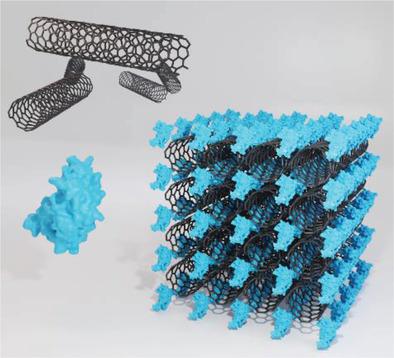当前位置:
X-MOL 学术
›
Adv. Healthcare Mater.
›
论文详情
Our official English website, www.x-mol.net, welcomes your feedback! (Note: you will need to create a separate account there.)
Biomolecule‐Directed Carbon Nanotube Self‐Assembly
Advanced Healthcare Materials ( IF 10.0 ) Pub Date : 2020-10-29 , DOI: 10.1002/adhm.202001162 Eduardo Anaya‐Plaza 1 , Ahmed Shaukat 1 , Inka Lehtonen 1 , Mauri A. Kostiainen 1
Advanced Healthcare Materials ( IF 10.0 ) Pub Date : 2020-10-29 , DOI: 10.1002/adhm.202001162 Eduardo Anaya‐Plaza 1 , Ahmed Shaukat 1 , Inka Lehtonen 1 , Mauri A. Kostiainen 1
Affiliation

|
The strategy of combining biomolecules and synthetic components to develop biohybrids is becoming increasingly popular for preparing highly customized and biocompatible functional materials. Carbon nanotubes (CNTs) benefit from bioconjugation, allowing their excellent properties to be applied to biomedical applications. This study reviews the state‐of‐the‐art research in biomolecule–CNT conjugates and discusses strategies for their self‐assembly into hierarchical structures. The review focuses on various highly ordered structures and the interesting properties resulting from the structural order. Hence, CNTs conjugated with the most relevant biomolecules, such as nucleic acids, peptides, proteins, saccharides, and lipids are discussed. The resulting well‐defined composites allow the nanoscale properties of the CNTs to be exploited at the micro‐ and macroscale, with potential applications in tissue engineering, sensors, and wearable electronics. This review presents the underlying chemistry behind the CNT‐based biohybrid materials and discusses the future directions of the field.
中文翻译:

生物分子定向碳纳米管自组装
在制备高度定制和生物相容的功能材料中,将生物分子和合成成分结合以开发生物杂交物的策略正变得越来越流行。碳纳米管(CNT)受益于生物共轭,使其具有出色的性能可应用于生物医学应用。本研究回顾了生物分子-CNT共轭物的最新研究,并讨论了将其自组装成分层结构的策略。这篇综述着重于各种高度有序的结构以及由结构顺序产生的有趣特性。因此,讨论了与最相关的生物分子,例如核酸,肽,蛋白质,糖和脂质缀合的CNT。由此产生的定义明确的复合材料可以在微观和宏观上利用CNT的纳米级特性,并在组织工程,传感器和可穿戴电子产品中具有潜在的应用。这篇综述介绍了基于碳纳米管的生物杂化材料背后的基本化学原理,并讨论了该领域的未来方向。
更新日期:2021-01-06
中文翻译:

生物分子定向碳纳米管自组装
在制备高度定制和生物相容的功能材料中,将生物分子和合成成分结合以开发生物杂交物的策略正变得越来越流行。碳纳米管(CNT)受益于生物共轭,使其具有出色的性能可应用于生物医学应用。本研究回顾了生物分子-CNT共轭物的最新研究,并讨论了将其自组装成分层结构的策略。这篇综述着重于各种高度有序的结构以及由结构顺序产生的有趣特性。因此,讨论了与最相关的生物分子,例如核酸,肽,蛋白质,糖和脂质缀合的CNT。由此产生的定义明确的复合材料可以在微观和宏观上利用CNT的纳米级特性,并在组织工程,传感器和可穿戴电子产品中具有潜在的应用。这篇综述介绍了基于碳纳米管的生物杂化材料背后的基本化学原理,并讨论了该领域的未来方向。


























 京公网安备 11010802027423号
京公网安备 11010802027423号